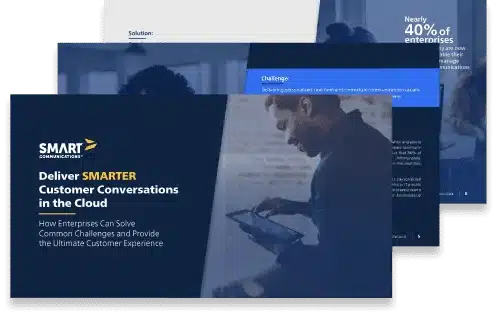Modernizing the Workers’ Compensation Claims Process
By: Ruth Fisk, VP Insurance Strategy at Smart Communications
Our world is rapidly changing. Technology advances across industries and all kinds of interactions have elevated the expectations for convenience, immediacy and ease for businesses and individuals, alike. Unfortunately, the typical workers’ compensation claims process is largely manual when it comes to claims communications. The good news? There is an opportunity for insurance companies to improve efficiencies and return-to-work results by adopting a more digital-first approach.
A Proven Approach Ready for a Refresh
Workers’ compensation was first introduced in the late 19th century during the second wave of the industrial revolution – a time of rapid changes in the technology and social landscapes. A flurry of innovations reshaped the world — the steam engine, the metal detector, seismograph, telephone and the first working automobile. These innovations and others simplified and sped up work, but they also posed a higher risk of accidents and injuries.
In 1871, wanting to win the loyalty of workers, Chancellor Bismarck of Germany issued the Employers’ Liability Law. It provided limited social protections to workers in certain factories, quarries, railroads and mines. He later expanded on these initial protections by establishing the Workers’ Accident Insurance in 1884, creating the first system of workers’ compensation.
Workers’ compensation guidelines and policies continued to evolve as new technologies and innovations were introduced. Often, these developments were created to address new and evolving risks that workers faced. Fast forward to today: while the widespread adoption of new, digital-first consumer technologies continues, workers’ compensation schemes remain complex and highly manual. There is a clear opportunity to modernize the worker’s compensation claims process.
Improving Life Outcomes with SMARTER Conversations
Since innovations and workers’ compensation policies have long developed in tandem, the opportunity to reimagine the approach is appropriate at this time. For insurers, their clients and injured workers, modernizing workers’ compensation claims communications can improve outcomes across the board.
When an employee gets hurt on the job, it has large-scale impacts on the individual, company productivity and even the broader GDP. For everyone involved, it is an emotional and stressful process. By optimizing orchestration, personalization and timing of communications through a unified customer conversations management platform, everyone benefits.
The primary objective of workers’ compensation is to get people back to work and resume productivity as quickly as possible. The Smart Communications Conversation CloudTM provides a seamless approach from policy inquiry, reporting of First Notice of Injury and managing claims to coordinating care and billing communications. By digitizing the effort, insurers can improve the process for everyone. And most importantly, better, more regular communications have been shown to improve life outcomes for the injured worker.
The Conversation Cloud provides a seamless experience for all. It is fully compatible and can be integrated with common core systems such as Guidewire ClaimCenter, Duck Creek Claims and Sapiens ClaimsPro. It is easy and fast to deploy and can quickly and positively impact the process. Instead of manual, siloed communications, Smart Communications unifies them under one solution.
Creating a Workers’ Compensation Claims Process for the Future
From emails and chatbots, to social media platforms and more—there are endless ways to interact with individuals today. Instead of the traditional one-way communications of the past, now case managers have the opportunity to start conversations with injured workers, company representatives and even care providers. By deepening the level of personalization and improving the immediacy of communications, insurers have a powerful opportunity to meet today’s expectations and advance workers’ compensation approaches for everyone.
When communications are conversational, personalized and SMART, everyone is more willing to engage. Think of it as the latest improvement to what has been a revolutionary approach from its earliest days. By transforming the approach to the workers’ compensation claims process, insurance companies have the opportunity to literally change lives.
—
Interested in learning more about how modernizing the workers’ compensation claims process will impact the case manager? Download “The Case Manager of Tomorrow” to learn how a cloud-first approach enables case managers to work SMARTER.



